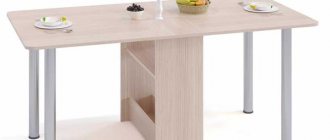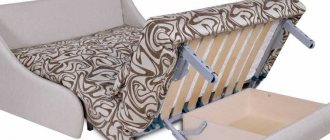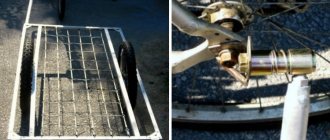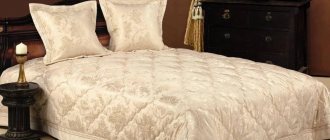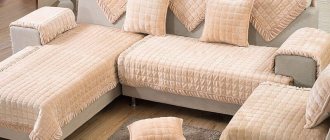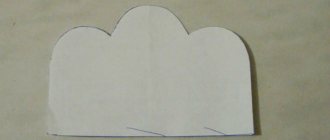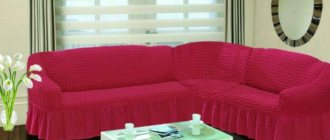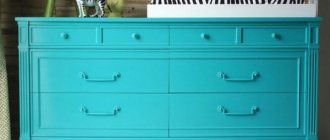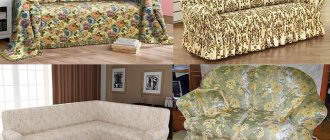Where to begin?
Before taking on such a responsible task, and even without the proper experience, you should sensibly assess the situation and understand whether your sofa is really worth reupholstering. There are cases when the furniture already resembles a wreck, but it’s still a shame to throw it away. But at the same time, everyone in the household is just waiting for the moment when something will finally break, so that there will definitely be a reason to take it far away. In such cases, even independent restoration will reach the price tag of a new piece of furniture. Therefore, you should not go to extremes. The exception is when the sofa is valuable as a family heirloom or is an antique. There are several other situations when you should refrain from making your own replacement, for example:
- When the cost of a sofa is very high and there is a high probability of ruining it;
- When the sofa has a too complex configuration;
- When disassembling the furniture yourself is not possible due to too complicated assembly;
- When the service life of the product is so long that the frame and spring block become deformed;
- When you have chosen a fabric that is too thick or too specific for the new upholstery, only professional furniture makers can cut and fasten it.
If, nevertheless, a clear decision is made to act, it will be necessary to go through all the labor-intensive restoration processes, namely:
- Dismantling an old piece of furniture into individual elements;
- Complete removal of worn upholstery and sometimes filling;
- Thorough inspection of the frame, spring block and other parts;
- Choosing new upholstery material;
- Upholstery cutting;
- Fastening fabric to individual furniture parts;
- Reassembly of the structure.
Let's take a closer look, taking into account key tips from cabinet furniture manufacturers and restoration and reupholstery specialists.
Benefits of restoration
Many citizens are suspicious of restoring old furniture, although it has a lot of undeniable advantages. These include:
- saving money;
- independent choice of design;
- preserving memories associated with an antique item;
- improvement of weak points of the design to increase ease of use.
Budget savings
The main plus for which many decide to restore the sofa. Updating parts that have exhausted their service life costs much less, and the remaining money can be spent on more pleasant needs.
Antique Preservation
Old, antique things have always been valued. Why throw away a good, sturdy sofa that has a lot of memories attached to it? It’s easier to refresh its appearance and continue to use it for your pleasure. Perhaps in the future, the money saved on buying a sofa will be better used.
Choice of colors
When purchasing new furniture, the problem of choosing the right color scheme that harmoniously fits into the current interior of the room often arises. In case of restoration, it is much easier to buy fabric of the desired color, and this saves not only money, but also time.
Independent selection of material according to quality
Another undoubted advantage is the ability to choose the quality of the material used for restoration. An old sofa can be covered with more expensive fabric, which will significantly increase its appearance. At the same time, the price of a new product made from the same material will be many times higher.
Strengthening weak points
Buying new furniture always carries the danger of unexpected defects or design flaws that reduce the ease of use. All the disadvantages of old furniture are already known and they can always be eliminated by purchasing a couple of extra parts. This way you will update the appearance and strengthen the structure as a whole, with a minimum investment.
Stage I - dismantling the old sofa
If your sofa is a standard configuration, the process will not be difficult and will last about an hour. In order for everything to be quick and organized, first of all, you need to prepare all the necessary tools:
- You definitely can't do without a set of screwdrivers;
- A set of wrenches for nuts or bolts;
- In the absence of keys, pliers will do.
Dismantling must begin with those elements whose fastenings are visible. Usually these are the sides of the sofa, after unscrewing which, the nuts that secure the lifting mechanism are revealed. After removing the mechanism, you can disconnect the back and seat. If the sofa has legs, you can start disassembling them. At this stage it is very important to keep all fasteners intact. If in some places the parts are connected to each other using grooves and protrusions, you should not make sharp jerks so as not to break them.
Be sure to remember the sequence of your actions. After all, you have to assemble the furniture using the reverse pattern. It is important to remember which of the fastening elements connected this or that part of the sofa. Otherwise, in the end it may turn out that this bolt is not the right length, and the required one is already hidden somewhere under the sidewalls. We'll have to take everything apart again.
Photo of reupholstering upholstered furniture with your own hands
Look here: Red sofa: bright and stylish room decoration ideas. 115 photos of current combinations for 2020
Did you like the article?
0
2
Stage II - removing old upholstery
When the sofa appears in front of you in the form of separate parts, you need to carefully remove everything that is old and has lost its visual appeal and functionality. Be prepared for the fact that you will have to get rid of more than one hundred staples from a furniture stapler. This process can become very painstaking and annoying if you do not prepare all the necessary tools in advance:
- First of all, the bracket will need to be pryed off with something; a thin flat-head screwdriver will do for this;
- Now you need to remove it; pliers or round nose pliers will do for this;
- A utility knife may come in handy.
The work will progress much faster if you first pry up all the staples on each part and then remove them. There will be no time wasted changing working tools. To avoid finding staples later in the most unexpected corners of the apartment and to avoid injury, immediately prepare a garbage bag.
When removing fasteners, be careful not to cut the fabric itself. At the stage when you need to cut new upholstery, you can use old fragments as patterns. Under the fabric you will find filler. It can be foam rubber or other materials. In older models, filler often fills the space between the springs. You need to carefully pull it out too.
When starting this stage, after you have prepared the necessary tools, we recommend that you cover the area of the floor on which you will be working with oilcloth. The old filler can simply crumble in your hands and turn into dust, which will quickly spread throughout the apartment. There will be a lot of garbage.
Stage III - visual inspection and identification of problem areas inside the structure
There is no point in wasting time and effort replacing the upholstery if the inside of the sofa is damaged. A beautiful fabric will not hide the holes that form when the filler loses its density. It will not hide sagging structural elements, which are the result of a stretched spring block. It is for this purpose that it is necessary to completely clean the frame of all unnecessary things - in order to find and eliminate faults. Under the filler you will find springs or mesh or belts. All these components, including the joints of the wooden frame itself, must be carefully examined. If the springs have stretched, the belts have burst and torn, and metal or nylon stretchers no longer perform their functions, all this must be replaced with new parts. Very often the springs burst in the middle of the seat.
If you find
cracked wooden beams, they also need to be replaced without fail.
To do this, choose well-dried wooden beams without knots and cracks. The presence of such defects will serve as stress concentrators, and under heavy load the crossbar will soon burst again. Damp wood, gradually drying out under the influence of the temperature in the apartment, will become deformed, which can cause distortion of the entire frame. Craftsmen advise impregnating the joints of new and old beams with PVA glue before reassembling. In older models, the frame has three fiberboard jumpers, one in the middle and two on the sides. Very often they also burst after many years of use. It is useless to repair such parts. It's better to do a complete replacement. You can attach the jumpers to the frame using small nails; a faster way is to use a pneumatic stapler.
As for the filler. In 95% of cases it needs to be thrown away. To replace the worn one, you need to purchase new foam rubber of medium or high degree of rigidity with high density values. Its height should be at least 45-50 mm, and better yet – 60 mm. This will not only make the seat more elastic and give it an attractive shape, but will also protect the internal parts from damage. To ensure a longer service life of the filler itself, it is recommended to wrap it with several layers of padding polyester. If you need to change the filling in the back, you can use foam rubber of a less high degree of rigidity. This will make your stay more comfortable.
Very often the lifting mechanism itself becomes loose , uncharacteristic play appears or the springs fall off altogether. If the problem is not resolved by replacing the screw or spring with a stiffer one, you should buy a new lock.
As you can see, reupholstering a sofa yourself is not only about replacing the top upholstery. This is the replacement of all structural elements that have lost their original appearance. Only such comprehensive work will lead to the desired result and give a second life to old furniture. Of course, if your sofa was simply damaged by pets, or you decided to fit the furniture into a new interior by changing its color, then you may be lucky enough to avoid all this.
Design
The advantages of restoration are more or less clear, now it’s time to understand the design of the sofa. This will allow you to determine the importance of a particular part, the amount of work to be done and the approximate cost of repair.
Frame
The basis of the structure, which bears the heaviest loads. Try not to purchase products made from chipboard. They are too fragile and quickly become unusable. A good frame is expensive, but the service life of such furniture is much longer.
Spring block base
An important detail responsible for ease of fit. If it is damaged or fails, the structure becomes inconvenient to use, and its working life is exhausted faster than usual.
Spring block
The spring block base provides the seat with elasticity and comfort. If it fails, the sofa will begin to make creaking sounds, wear out faster and spoil the upholstery from the inside. You shouldn't let your furniture get into this state. Timely repairs will solve many problems and contribute to further savings.
Felt or thick fabric
Felt is a natural material used in the assembly of sofas. Felt, or thick fabric, is used in old-style sofas as a protective layer and there are usually no problems with replacing them.
Polyurethane foam
Cheap and durable filler, widely used in the furniture industry. Polyurethane foam comes in two types:
- block;
- cast.
See also
Basic methods for removing tiles from bathroom walls
Note! To fill sofas, polyurethane foam is used, the density of which ranges from 30 to 40 kilograms per square meter. Fillings with a density below 30 kilograms are used only for the manufacture of decorative pillows.
Sintepon.
Synthetic filler made from non-woven fabric. It is used in budget designs due to its low cost.
Most often, it is not used as a basis for filling upholstery, but is combined with other, higher quality materials.
Upholstery fabric
The upholstery fabric is responsible for the decorative properties of the sofa and protects it from external influences. The higher quality and more expensive the upholstery, the longer the furniture retains its fresh, presentable appearance. There are a large number of materials for these purposes - you will always have plenty to choose the best option from.
Stage IV - choosing new upholstery
It's time to begin the most creative stage of our work - choosing new, beautiful upholstery. First you need to decide on the required amount of material. This will be very easy to do if you measure all parts of the old fabric and add a margin of 0.5 meters to the resulting amount. Firstly, you can make a mistake during the cutting process, and secondly, since you are doing this for the first time, for convenience, you need to leave more space for the folds. What to look for when choosing a new upholstery fabric:
- Of course, you should immediately decide on the color scheme . If the sofa plays the role of a color accent, then your imagination is not limited by anything. The main thing is that such an element is supported by a couple more small details of the same color, for example, vases or frames. In other cases, the color of the upholstery should harmoniously complement the overall interior of the room. It can be matched to the color of the curtains or to the color of the feature wall.
- Presence or absence of a drawing . Everything here is purely individual. Of course, against the background of striped walls, a sofa with striped upholstery will blend in or, conversely, ripple, and against the background of wallpaper with small flowers, a polka dot sofa will look ridiculous. Therefore, follow a simple rule: upholstery with a pattern is acceptable against a plain wall, but not against a patterned one. But plain upholstery against the background of neutral walls, on the contrary, will look strict and elegant, especially if you choose a noble, muted shade. And keep in mind that fabric with a distinctive geometric print will be harder to work with. Every minute you will need to monitor whether the drawing is skewed in relation to the edges and other straight surfaces. Such an error will be very noticeable, and it will need to be masked with pillows or the work redone.
- Along with external attractiveness, one should not forget about the practical side of the issue . The fabric must have increased wear resistance, taking into account the daily loads that it will experience. It is desirable that it be easy to care for.
- The room in which the sofa is supposed to be installed after reupholstering also plays an important role. For the living room, certain types of materials will be preferable, while for the dining room, where there are always different characteristic odors and a higher likelihood of stains, completely different materials should be chosen.
- Financial opportunities. If you are not limited in this regard, then, of course, it is better to choose genuine leather as an upholstery material for the same sofa in the dining room. Otherwise, textiles. But in no case should you replace cracked and peeling leatherette with the same, only new one.
Considering all these points, the choice can be quite difficult. Below we will provide a short list of the most popular upholstery materials and their performance characteristics so that you can quickly find your way around.
- Microfiber is a type of synthetic fabric that is highly resistant to various stains, high humidity and temperature changes, and is affordable. Therefore, it is very easy to maintain. Good quality microfiber is highly breathable and hypoallergenic. To confirm this, you must ask the seller to present the appropriate quality certificate. This material will be ideal for a kitchen sofa. The only drawback is that it is flammable. To avoid trouble, simply place furniture away from the gas stove. The color palette is quite diverse, there are both plain and colorful varieties. There will be plenty to choose from.
- Fleecy fabrics, such as velor or plush , are very soft and delicate. They quickly lose their color under the influence of ultraviolet radiation and have a low degree of abrasion resistance, which makes them unsuitable for upholstering a sofa that will be used daily. An exception is a material called flock with a diagonal weave of fibers, which in appearance resembles velvet. It is slightly less durable than microfiber, but is more attractive in appearance and is suitable for upholstering a sofa in the living room. The advantage of flock is its resistance to food and other contaminants. Modern flock has a special silicone coating, and its surface is very soft and pleasant to the touch.
- A chic but expensive material is jacquard. It is distinguished by high performance characteristics and a rich, varied palette of colors and textures. Its surface practically does not wear out and does not fade. The fabric itself is very dense and durable. However, if you have pets or children, then you should think about it, because caring for jacquard is very difficult. It does not tolerate contact with damp fabric and is more suitable for strict, classic interiors, and its surface is cold to the touch.
- Tapestry is a type of fabric with a high degree of wear resistance and density. Able to keep its shape well. Retains stability and richness of color for a long time, regardless of the influence of external factors. The tapestry has antistatic properties. The color palette is also very diverse. All this makes this material very popular among furniture manufacturers.
- Chenille - a type of natural fabric with the addition of synthetic and artificial fibers, considered an ideal option for upholstering sofas. Its peculiarity is its very high strength, which is achieved by a special production method and the addition of a small amount of synthetic fibers. This fabric is very warm and pleasant to the touch. Sitting on such a surface will be very comfortable. And any dirt can be easily removed from the surface with an alcohol or vinegar solution.
Stage V - making a pattern
Once a suitable fabric has been selected, you need to cut it into fragments. To simplify the process, use old upholstery, which must first be shaken out or vacuumed well.
- Spread the fabric on the floor and place all the pieces of the old upholstery you removed on it.
- Keep the layout as compact as possible, but do not forget to leave an allowance around the edges if you need to sew the covers together. Thus, between each part you should have gaps about 8-10 cm wide.
- Now you need to circle all the elements. Use a bar of soap or chalk for this if the fabric is dark, and a simple pencil if it is light.
- To avoid the parts moving, you can pin them using sewing pins.
- Now you need to sew covers for the sides and other elements, if this was the case initially. It’s good if you have a sewing machine at home and you’re comfortable with it. Otherwise, you need to contact the studio for help and be sure to ask that all edges be overlocked. This will protect the edges from fraying. It is very important to monitor the direction of the weft and warp threads. They must match on all parts. It is very easy to determine - the weft thread stretches, the warp thread does not.
Operating rules
The basic rules for using sofas include:
- When moving furniture from place to place, do not drag the sofa along the floor, but lift it.
- Periodically check the reliability of the fasteners, as over time they become loose.
- Do not exceed the permissible load capacity specified by the manufacturer.
- Sofas with a built-in mattress are laid out at least once a month.
Decoding the icons on clothes Test for cleanliness in your home Laundry weight calculator Ask a question to an expert
Share link:
Stage VI – securing the new tissue
Finally, everything is ready, the beautiful new covers have already been sewn, and it’s time to attach them to the parts of the sofa. You must understand that the final result depends on this stage. Whether the surface of your sofa will be smooth and flawless, or whether folds and distortions will form on it, depends only on you. Therefore, you need to work slowly and carefully. It’s better to try on all the covers first, because for now you have time to make adjustments. You may have to sew something in by hand, cut something somewhere, there’s nothing wrong with that. Better to discover it now. It is better if the cover fits tightly than loosely. In the latter option, when secured with staples, folds may form. So, the sequence of your actions:
- Preliminary fitting of all elements and modification as necessary;
- After putting the cover on the part, straighten the fabric with ironing movements. You don't need to stretch the fabric too much, otherwise it will wrinkle. If the fabric has a bevel, make sure that the fabric lies evenly, without characteristic bends. It is better to start attaching the brackets from the most visible part, gradually moving to the end or corners, where the imperfections will be invisible.
- In the places where the mounting holes are located, it is necessary to cut small similar holes in the upholstery fabric. The edges of the fabric around the hole need to be secured with staples.
- The staples should be located at a distance of 35-40 mm from each other, no more, their optimal length is 14 mm.
- If the wood is too dense or the fabric is too thick and the staples don't go all the way in, tap them lightly with a hammer.
- After securing the upholstery, you need to cover the wrong side with lining fabric. You don't need a pattern here. Just attach it to the desired part and cut off the required piece in place with an allowance of 3-4 cm on the sides. It is necessary so that you can make a turn and it is convenient for you to work. This fabric should begin to be attached from the corners, while pulling it tightly.
This is the difficult and painstaking process of reupholstering a sofa with your own hands. But if you complete all the steps thoughtfully and measuredly, the result will exceed all your expectations. And your new “old” sofa will delight you for several more years.
Decoration
Decorating the sofa is done using:
- creating beautiful pillows;
- carriage screed;
- figured solid wood.
Beautiful pillows
Pillows are made independently, from leftover material, or purchased in a store. It all depends on your financial capabilities.
Carriage tie
The back of the sofa is decorated with a carriage tie. To do this, small circles are cut out of the foam rubber during stuffing, after which buttons will be sewn in their place. This will help prevent the material from curling. Afterwards the frame is covered with fabric and decorative elements are sewn on.
Figured wood
Wooden armrests can be decorated by gluing solid wood onto them. Such a sofa will look much more beautiful and will last longer than usual.
Nuances of the process of working with genuine leather
Genuine leather is a very pleasant and pliable material, it is a pleasure to work with it, you just need to follow a few recommendations.
- The optimal thickness of the material for independent work with it is no more than 1.5 mm. This leather fits well, is easily leveled and simply fixed. If you decide to give preference to a denser material, about 3 mm thick, then you simply will not be able to form beautiful folds where it is needed or you will not be able to properly tension it.
- Under no circumstances should the skin be wetted before fixing. Yes, in this state it really stretches well and takes the necessary shape, but as soon as the material begins to dry, it will shrink, and you will get numerous wrinkles or even damage to the expensive upholstery at the attachment points. Wet skin is stretched only when it is necessary to achieve a high degree of surface tension. But this is furniture, not a drum.
- When sewing leather covers and cutting new ones according to old patterns, under no circumstances should you use pins, which will leave noticeable punctures. You can use adhesive tape to pre-fasten the parts.
- To prevent the sewing machine foot from leaving characteristic scratches, the material at the seam must be lubricated with Vaseline.
- Material that was left for seam allowance on the back side may form obvious bumps and unevenness on the front side. To avoid this, you need to spread it on both sides of the seam and iron it through gauze.
Apart from these points, the technology for upholstering a sofa with leather is similar to the steps described above. Of course, such a sofa will look more respectable, and caring for it will be easier than textiles.
Tags:Sofa
